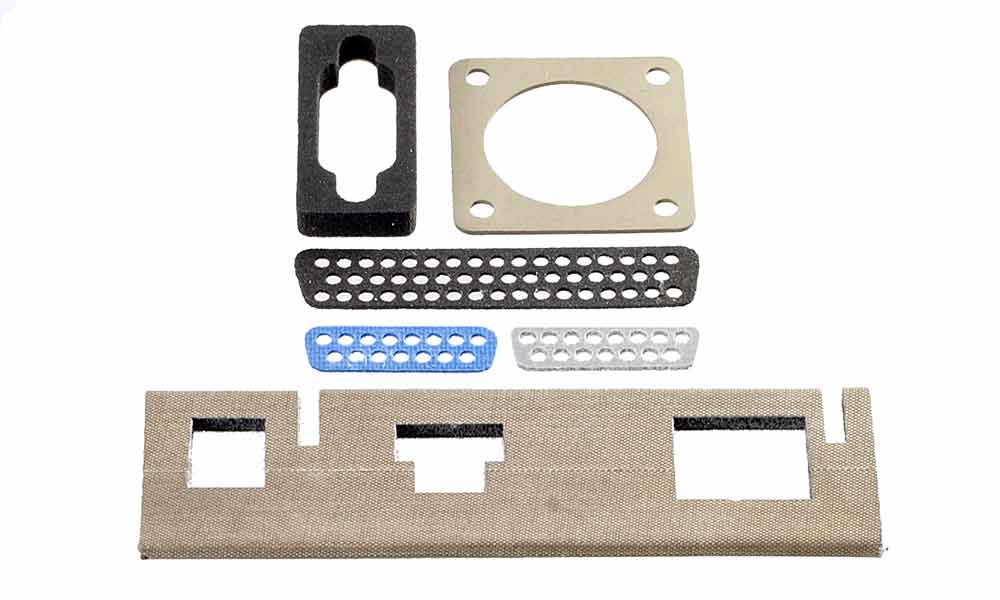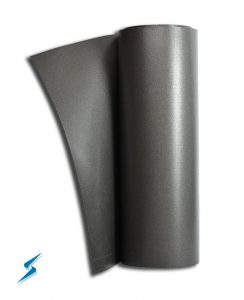
Stockwell Elastomerics manufactures custom electromagnetic interference (EMI) shielding gaskets and other EMI/RFI management gaskets from various EMI shielding materials to customer specification. Designing and producing these gaskets requires a knowledge of EMI; a summary of that background information is provided here as a technical resource.
Electromagnetic interference (EMI) is a disturbance that interrupts, obstructs, degrades, or otherwise limits the effective performance of electronics and electrical equipment. The “electromagnetic” in EMI refers to how electric current has electrical and magnetic forces and effects. The “interference” in EMI refers to how when an electromagnetic signal is transmitted, or propagated, that signal can be received by a circuit that is not the intended recipient.
EMI vs. RFI
EMI is associated with but not identical to radio frequency interference (RFI), an electromagnetic disturbance that affects radio frequency (RF) communications. The RF portion of the electromagnetic spectrum includes radio waves and microwaves, so RFI isn’t limited to RF devices. Typically, however, RFI refers to lower-frequency interference from an external source while EMI refers to higher-frequency interference from the device itself. EMI and RFI affect devices differently, but they both affect electromagnetic compatibility (EMC), the ability of different devices to operate without mutual interference.
Types of EMI
The way that electromagnetic signals travel, or propagate, provides a way to categorize types of electromagnetic interference. The origin of the interference itself also provides a way to describe the type. The signals that cause EMI are propagated through conduction or radiation; both are explained below.
Conducted EMI occurs when the interference travels along a direct route from a source to a receiver. Power cables and electrical interconnections can provide such a route, but so can parasitic capacitance between parts of an electronic component or circuit. Electrical motors, DC/DC converters, Ethernet traffic, and switch-mode power supplies are all sources of conducted EMI. There are two types of conducted EMI: common mode and differential mode.
- Common mode EMI happens simultaneously on two receiver lines. The signals are in the same direction and phase as the receiver lines, and each returns to a common ground.
- Differential mode EMI happens in closed-loop circuits when the electrical current flows in directions opposite the signal line.
Radiated EMI does not require physical contact between a source and a receiver. Instead, the interference travels through the air. Because radiated emissions spread outward and can travel long distances, radiated EMI can affect devices that are either close by or far away. Many of the same sources that cause conducted EMI can cause radiated EMI; however, radiated EMI is also caused by overhead power transmission lines, AM/FM radio signals, radar systems, wireless communications, and electronic jamming devices.
What is EMI Shielding?
 EMI shielding protects the circuits in electronic devices and electrical equipment from conducted and radiated EMI, along with human-induced or naturally-occurring electromagnetic interference. There are different types of EMI shielding, but most either consist of or contain metal. That’s because metal is electrically conductive and supports the free flow of electrons. When there is electronic “noise”, the EMI shielding prevents these signals and the resulting electrical current is sent to ground. By preventing harmful signals from entering or escaping, communications also remain cleaner.
EMI shielding protects the circuits in electronic devices and electrical equipment from conducted and radiated EMI, along with human-induced or naturally-occurring electromagnetic interference. There are different types of EMI shielding, but most either consist of or contain metal. That’s because metal is electrically conductive and supports the free flow of electrons. When there is electronic “noise”, the EMI shielding prevents these signals and the resulting electrical current is sent to ground. By preventing harmful signals from entering or escaping, communications also remain cleaner.
Where is EMI Shielding Used?
EMI shielding is used in industries ranging from consumer electronics, telecommunications, and information technology (IT) to automotive, aerospace, defense, space, and medical device manufacturing. Some EMI shielding, such as specialized adhesives, are applied to printed circuits boards (PCBs). Others are applied as coatings or paints to enclosures and cables. EMI shielding can be used between noisy components within a device, or to seal the entire enclosure. Regardless of the enclosure material, however, EMI gasketing is used to fill the gaps between mating surfaces such as lids and panels.
Why are Electrically Conductive Silicone Elastomers Used for EMI Shielding?
Electrically conductive elastomers, silicone and fluorosilicone in particular, provide specific levels of EMI shielding and can be fabricated into gaskets and other types of products, such as EMI O-rings. Like plastic, silicone is normally an electrical insulator; however, the addition of metal or metal-coated particles makes it electrically conductive. As the base elastomer, silicone and fluorosilicone provide high elasticity, high compressibility, strong environmental resistance, and broad temperature resistance. Silicone isn’t the only rubber that can be used in EMI shielding, but its material properties make it an attractive option for high performance and demanding environments.
Silicones vs. Fluorosilicones
Silicones are a family of semi-organic/inorganic elastomers that include fluorosilicones. With their fluorine additions, fluorosilicones maintain the excellent high temperature stability and mechanical properties of silicones while offering greater resistance to fuel, oil, and other chemicals. Like silicones, fluorosilicones support the addition of metal or metal-coated particles. Both types of EMI elastomers are supplied as sheets, rolls, extrusions, and complex molded components. Sheets and rolls can be converted into EMI gaskets from solid, foam, or combination materials with silicone sponge and a wire mesh.
Metals vs. Other Fill Materials
The particles in EMI silicones are made of pure metal, highly conductive metal coated over a less conductive metal (bimetalic), or a metal deposited over a non-metal. Pure silver offers excellent electrical conductivity, but it’s more expensive. Bimetallic particles include nickel-aluminum, silver-aluminum, silver-copper, and silver-nickel. Nickel-graphite and silver-glass are examples of particles made of a metal and a non-metal material. Wire oriented silicones for EMI shielding are filled with either a Monel or aluminum mesh. Monel, a group of nickel-copper alloys, provides excellent corrosion resistance. For galvanic corrosion, particle-filled silicones with nickel aluminum are good choice. Combination gaskets made of non-conductive sponge elastomers with a monel wire running along the edge are also used.
Contact Stockwell Elastomerics for EMI Gaskets and EMI Shielding
Contact Us for further assistance with EMI shielding gaskets and EMI shielding materials/electrically conductive silicone.

